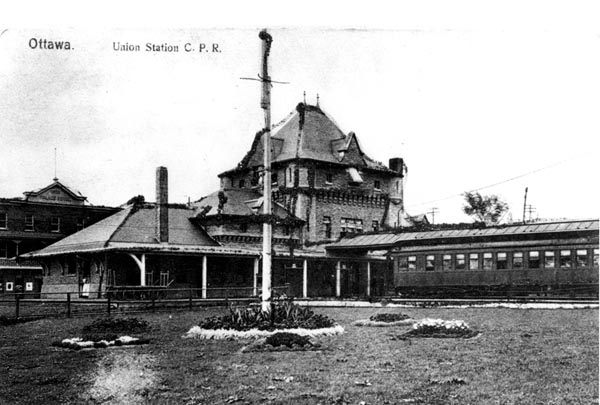|
Station Gardens
  A view of
Union Station,
National Library and Archives, PA 141292. The recent note in Branchline concerning the
shop foreman at
Ottawa West who cultivated a garden alongside the locomotives prompts
the
thought that, in earlier days, the Canadian Pacific Railway took a
great pride
in its passenger stations and actively encouraged flower gardens. This was particularly true at the Union
Station on Alderman Scrim was a well known local
horticulturalist. He had greenhouses in
the area and was
frequently called upon to judge flower shows, both in By 1896, the On 2 June 1899 the Ottawa Citizen commented that “The garden plot at the C.P.R. station has been made to look very attractive, the flower beds having recently been planted with a beautiful collection of flowers from Mr. C. Scrim's greenhouses.” The C.P.R. also beautified other stations
along the
line. In commenting on the new station,
the Renfrew Mercury of 22 May 1896 noted : “The C.P.R. station flower
garden
has been fenced in and seeded down. The
beds for the flowers have been prepared and the flowering plants from
the The Renfrew Mercury also commented on 30 September 1898: “The garden of the C.P.R. station here has been looking beautiful for some weeks. The season has been particularly favorable for the growth and coloring of the grass, and the beds of flowers laid out by florist Scrim are handsome. There has been much debate whether the white caps that have been growing so plentifully within the enclosure are mushrooms or toadstools. Perhaps there are both. Anyway, some folks who have hopped over the fence and plucked some of them are living yet.” Other stations along the By 1908, the C.P.R. had a floral department which was making annual distribution of seeds to stations and to ensure they were used to the fullest there was an annual station gardens competition. The Renfrew Mercury noted with pride on 10 November 1911: “Once again Renfrew's C.P.R. station figures in the list of prizes given by the C.P.R. company for the best kept gardens at the stations along their line. In district No.4, of which Mr. H.B. Spencer is superintendent, Caledonia Springs is awarded first prize, and Renfrew second prize. Though Mr. Dickson, as station master, is credited in the published list with being the winner, he always accords the praise for the neat and tasty appearance of the station garden here to Mr. Godfrey, the baggage master.” Canadian Pacific was not the only railway which improved the appearance of its stations by encouraging staff to take up gardening. There was a small garden at the Canada Atlantic Railway Central Depot which could be viewed by passengers descending the stairs to the platforms. However, the C.P.R. made a concerted effort, with the help of a local horticulturalist, to ensure that its efforts paid off to the maximum. Sources:Ottawa Citizen: 24 June 1892; 3 August 1896; 2 June 1899; 7 June 1901. Renfrew Mercury: 22 May 1896; 30 September 1898; 3 April 1908; 10 November 1911. Bytown Railway Society, Branchline, May 2007. |